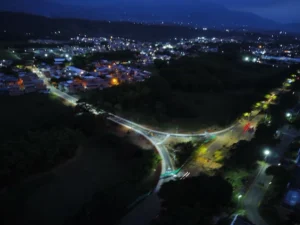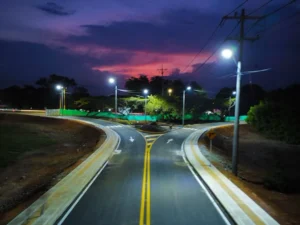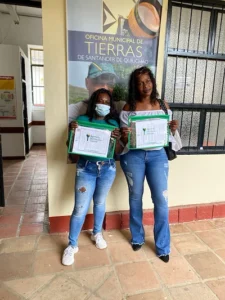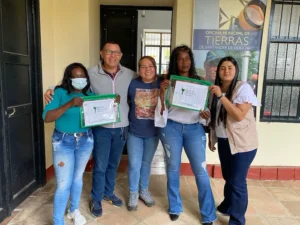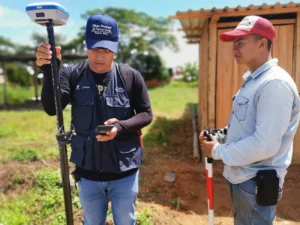The USAID-supported Municipal Land Office in Santander de Quilichao plays a significant role in planning and mobilizing funds for urban development.
At rush hour, dense traffic permeates downtown Santander de Quilichao and slows to a trickle. Cars, buses, and delivery trucks ply the few single-lane streets on a journey to the main arteries of Northern Cauca that connect the highway Panamericana to major cities like Cali and Popayan. For decades, municipal leaders have discussed ways to alleviate the city’s traffic issues by building new roads, improving urban planning, and gathering community input.
This year, traffic patterns in Santander de Quilichao are finally shifting. Drivers coming from nearby municipalities of Caloto, Toribio, and Guachene now have the opportunity to bypass the city’s center through the neighborhood of Niza, which lies north of downtown. The bypass measures less than a kilometer but includes a bridge over the Quilichao River, saving time for drivers, keeping heavy trucks out of the city’s center, and improving urban development for the community in Niza.
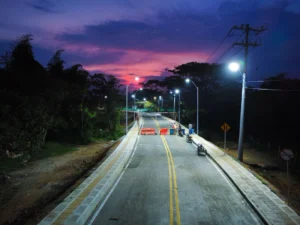 The idea of a road and bridge across the Quilichao has been on the minds of city planners for at least twenty years but was never realized until a team of land experts from the Municipal Land Office took over the process of acquiring the land on both sides of the river.
The idea of a road and bridge across the Quilichao has been on the minds of city planners for at least twenty years but was never realized until a team of land experts from the Municipal Land Office took over the process of acquiring the land on both sides of the river.
“The owners on one side of the river were never interested in ceding the land to the city, but when the Municipal Land Office reached out to the property owners to work together, we made them see that this road would increase property values in the neighborhood and the city’s efficiency,” explains Bernardo Pinzón, a social worker in the Santander de Quilichao’s land office.
With the properties lined up, Mayor Lucy Amparo Guzmán, the mayor of Santander de Quilichao, led the campaign to mobilize the 3,400 million pesos required to complete the roads project. City leaders and neighbors gathered in October 2022 to inaugurate the road and bridge, which includes an access ramp, LED streetlights, and sidewalks with wheelchair access.
The success story is the latest example of how land tenure issues lie behind every type of investment in essential public services and infrastructure in Colombia’s rural municipalities. In Santander de Quilichao, land informality rates are above 50 percent, meaning half of all parcels do not have registered land titles. In hundreds of other municipalities, it is much worse, reaching as high as 80 percent.
With the properties lined up, Mayor Lucy Amparo Guzmán, the mayor of Santander de Quilichao, led the campaign to mobilize the 3,400 million pesos required to complete the roads project.
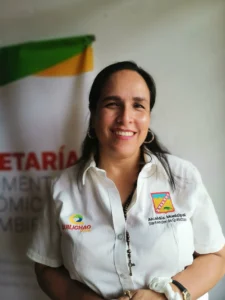
“Legalizing a property gives a project viability and gives the Municipality a chance to mobilize resources. That’s why the Municipal Land Office generates development and urban planning, not only in the short term but in the medium and long term as well. As mayor, I must plan for the next mayor, and the Municipal Land Office helps me in this role.”
-Lucy Amparo Guzman, Mayor of Santander de Quililchao
Titling Urban Properties
With USAID support, Santander de Quilichao’s Municipal Land Office was created in early 2017 as a one-stop shop for local land administration to facilitate rural development initiatives and help rural landowner access property services and information.
In its first iteration, the local land office titled hundreds of urban parcels, including public properties like health clinics, aqueducts, and schools. Among the lands titled in the name of the municipality is a parcel for a University of Cauca satellite campus, a SENA campus serving 1,500 students, a transportation terminal, and a hospital.
“The community values the Municipal Land Office and because of it knows that if community spaces like schools, roads, health centers do not have property titles in the name of the municipality, there is no way to invest in public services,” says Mayor Guzman.
With USAID support, the Municipal Land Office is working closely with the National Land Agency (ANT) to prepare for an upcoming massive land formalization initiative. The municipality’s Social Management of Rural Property Plans, known as POSPR, was approved in 2022, and teams are expected to begin the preliminary stages this year.
“The parcel sweep is very important for Santander de Quilichao. In addition to allowing people to access land and own property, the exercise helps us look at land use, including environmental protection, and it is documented, allowing us to plan better and project the municipality into the future,” says Mayor Guzman.
In 2022, the USAID Land for Prosperity Activity renewed its support for the land office, improving information systems and expanding staff and capacity to meet the public’s expectations. Since then, the office has delivered over 150 land titles to urban landowners.
A Successful Strategy
Since 2020, 37 USAID-supported Municipal and Regional Land Offices delivered over 3,000 land titles to families living in the urban areas of rural municipalities. In addition, the land offices have formalized more than 1,000 public properties and provided land and property services to nearly 32,000 citizens.



